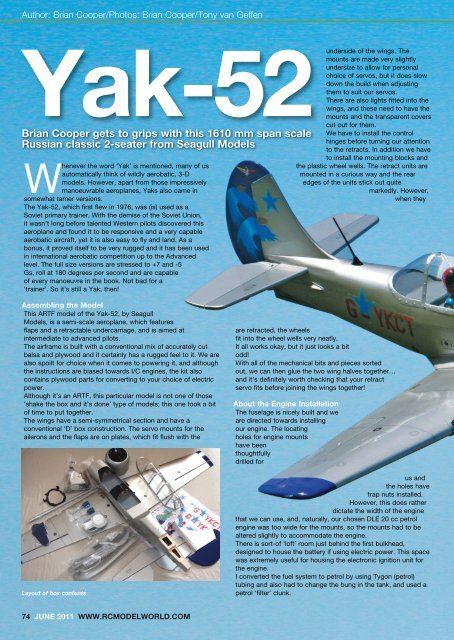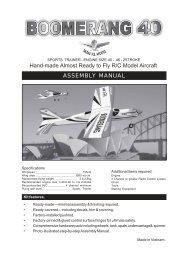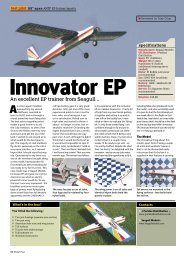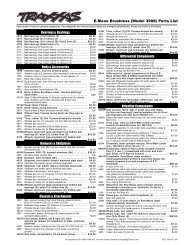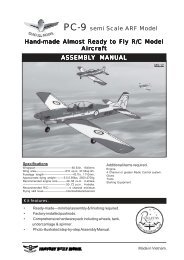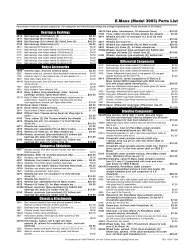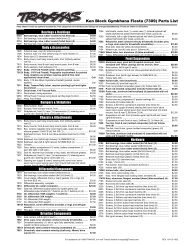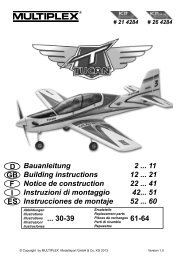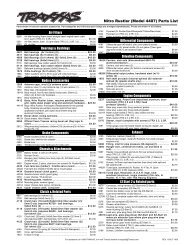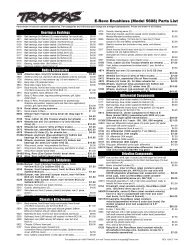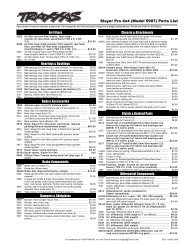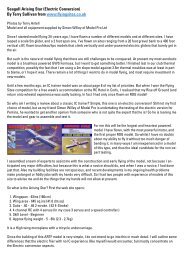Seagull Yak 52 review - J Perkins
Seagull Yak 52 review - J Perkins
Seagull Yak 52 review - J Perkins
- No tags were found...
You also want an ePaper? Increase the reach of your titles
YUMPU automatically turns print PDFs into web optimized ePapers that Google loves.
Author: Brian Cooper/Photos: Brian Cooper/Tony van Geffen<strong>Yak</strong>-<strong>52</strong>Brian Cooper gets to grips with this 1610 mm span scaleRussian classic 2-seater from <strong>Seagull</strong> ModelsWhenever the word ‘<strong>Yak</strong>’ is mentioned, many of usautomatically think of wildly aerobatic, 3-Dmodels. However, apart from those impressivelymanoeuvrable aeroplanes, <strong>Yak</strong>s also came insomewhat tamer versions.The <strong>Yak</strong>-<strong>52</strong>, which first flew in 1976, was (is) used as aSoviet primary trainer. With the demise of the Soviet Union,it wasn’t long before talented Western pilots discovered thisaeroplane and found it to be responsive and a very capableaerobatic aircraft, yet it is also easy to fly and land. As abonus, it proved itself to be very rugged and it has been usedin international aerobatic competition up to the Advancedlevel. The full size versions are stressed to +7 and -5Gs, roll at 180 degrees per second and are capableof every manoeuvre in the book. Not bad for a‘trainer’. So it’s still a <strong>Yak</strong>, then!underside of the wings. Themounts are made very slightlyundersize to allow for personalchoice of servos, but it does slowdown the build when adjustingthem to suit our servos.There are also lights fitted into thewings, and these need to have themounts and the transparent coverscut out for them.We have to install the controlhinges before turning our attentionto the retracts. In addition we haveto install the mounting blocks andthe plastic wheel wells. The retract units aremounted in a curious way and the rearedges of the units stick out quitemarkedly. However,when theyAssembling the ModelThis ARTF model of the <strong>Yak</strong>-<strong>52</strong>, by <strong>Seagull</strong>Models, is a semi-scale aeroplane, which featuresflaps and a retractable undercarriage, and is aimed atintermediate to advanced pilots.The airframe is built with a conventional mix of accurately cutbalsa and plywood and it certainly has a rugged feel to it. We arealso spoilt for choice when it comes to powering it, and althoughthe instructions are biased towards I/C engines, the kit alsocontains plywood parts for converting to your choice of electricpower.Although it’s an ARTF, this particular model is not one of those‘shake the box and it’s done’ type of models; this one took a bitof time to put together.The wings have a semi-symmetrical section and have aconventional ‘D’ box construction. The servo mounts for theailerons and the flaps are on plates, which fit flush with theLayout of box contentsare retracted, the wheelsfit into the wheel wells very neatly.It all works okay, but it just looks a bitodd!With all of the mechanical bits and pieces sortedout, we can then glue the two wing halves together…and it’s definitely worth checking that your retractservo fits before joining the wings together!About the Engine InstallationThe fuselage is nicely built and weare directed towards installingour engine. The locatingholes for engine mountshave beenthoughtfullydrilled forus andthe holes havetrap nuts installed.However, this does ratherdictate the width of the enginethat we can use, and, naturally, our chosen DLE 20 cc petrolengine was too wide for the mounts, so the mounts had to bealtered slightly to accommodate the engine.There is sort-of ‘loft’ room just behind the first bulkhead,designed to house the battery if using electric power. This spacewas extremely useful for housing the electronic ignition unit forthe engine.I converted the fuel system to petrol by using Tygon (petrol)tubing and also had to change the bung in the tank, and used apetrol ‘filter’ clunk.74 JUNE 2011 WWW.RCMODELWORLD.COM
product <strong>review</strong>Included is this extra wood pack for your optional choice of electricpower'the instructions are biasedtowards I/C engines’Thin cyano will hold the slotted Mylar hinges for the control surfacesThe cowl is made fromfibreglass and sits on aneat ‘ring’, which is boltedto the front firewall. It’squite a clever ideaactually! When the engineis installed, the cowl has tobe trimmed to fit. Happily, withthe way the cowl is designed, there is amassive area at the rear on both sides thatis open so cooling air can exit freely. With theengine installed, we can turn our attention to thetail end.Final FittingThe tailplane needs to have some coveringremoved before it can be glued into place.Removal, as always, should be done with great careto avoid scoring the wood, which could result in the tailfolding up in flight.The radio bay is huge and the servos are bolted to a specialplywood tray which, in turn, is bolted into the fuselage. The(piano wire) control runs to the rudder and elevators arealready configured for us and we merely need to make a90-degree bend in the wire and hook them onto our servos.The elevators are driven by one servo, but the linkage splits intotwo metal pushrods; these pushrods are connected together by alittle block and the individual piano wire is secured with a grubscrew. Being cautious, I also soldered the wires into place just inRemove film covering from this area to adhere the fin seatSteering tailwheel assists ground control; note the scale mouldedcovering over the tailwheel bracketWWW.RCMODELWORLD.COM JUNE 2011 75
<strong>Yak</strong> - <strong>52</strong>A neat radio installation, but I had to extend the rudder pushrod (seetext)The powerplant chosen was the DLE 20 cc petrol, which required alittle modification to the firewall but the space inside the cowl is ampleA standard size servo fits neatly into the aileron servo boxThree servo leads from each wing panel to be connected; note thecentral retract servocase the grub screws decided to work loose.Annoyingly, the rudder rod was about 2 inches too short and hadto be extended with the aid of some extra piano wire and somebrass tube.The model is now almost finished, so all we now need to fit arethe ‘pretty moulded bits’, namely the wing root fairings, oilcooler, tailwheel fairing, servo exits, etc. These are mouldedplastic parts, which look good but seem to be a bit thin andbrittle, nevertheless, they seem to work okay.The kit comes with two pilots for the cockpit, and the hugecanopy is just superb. It is of excellent quality and fits like aglove. The model also comes with a removable aerial that screwsinto the top of the fuselage to the rear of the cockpit canopy, anda pre-painted Pitot tube that slots into the left-hand wing.With all the bits and pieces added, we can now step back andadmire our new <strong>Yak</strong> <strong>52</strong>.Right, that’s enough drooling over it…The flaps are inset into the wingLet’s Fly ItThe DLE 20 was brand new (supplied by Gashangar) and it wasduly given one-hour running-in time to settle it in. It didn’t need asingle tweak on any needle and it sounded very sweet and verystrong on its 15" x 8" APC prop.With everything checking out nicely, there were no more excusesfor keeping it on the ground, so it was taxied out and pointedinto wind. The flaps were lowered to about 30%, and the throttlewas opened gently at first to check for any swing on the take-offrun, and then given full bore. The <strong>Yak</strong> accelerated briskly andwas airborne within a couple of seconds; wheels up and we wereclimbing nicely. Level off, the flaps were pulled up, the throttle76 JUNE 2011 WWW.RCMODELWORLD.COM
PRODUCT REVIEWMain retract unit is raised from the wing to give it the correct rakeangle and does not deter from the operation or flyingColourful nose artwork of the <strong>Yak</strong>Pre-painted pilot duo ‘in the office’Superb low flypast thatcould be for realA distinctive colour scheme with a ‘hi-vis’ overall silver covering, and she’s on a rollWWW.RCMODELWORLD.COM JUNE 2011 77
<strong>Yak</strong> - <strong>52</strong>totally out of harmony with the ailerons, which were like greasedlightning.The <strong>Yak</strong> was landed and taken back to the workshop for a fewadjustments to the C of G and the control throws. Fortunately there isa huge radio bay in the fuselage and it was an easy task to relocatethe batteries to a more rearward position.Having shifted the C of G rearward by 8 mm, we had another go. Thiswas much better, and the elevators now had some ‘life’ in them.The ailerons were still rather more lively than the elevators, but theywere getting closer.Ample power for big scale loops with the DLE 20was reduced to cruising power and we were able to examine thetrim to see if it needed any tweaks to keep it on an even keel.Quite a few beeps of trim (up elevator) got it going straight andlevel with hands off the sticks and then we could explore whatthe model could do.Despite having set-up the model as per the instructions, andbalanced it at the suggested C of G location, it was somewhatnose heavy, and the elevator response was a bit sluggish and'comes with two pilots forthe cockpit’Scale AerobaticsRighty-ho… the full size version of this aeroplane is supposed tobe an aerobatic machine, so it was given the works.The roll rate on this model is absolutely brilliant, even if it doesroll faster than the full size aeroplane. No doubt the purists mightwant to reduce the throws to emulate the full size performance.This is a fairly hefty model (it weighs over 10 lb with my set-up)and it has got a fairly high-ish wing loading. Nevertheless, thereis very little inertia build-up in a fast roll. The high wing loadingcomes in very handy when flying in windy conditions, as it seemsto enable the model to easily shrug off some quite breezyconditions.The huge, radial-engine cowl creates a large amount of drag,which is useful for managing the flying speed in the down-lines.However, the DLE 20 easily overcomes this drag to pull themodel vertical if required.The elevators are massive but they seem to be fairly tame at thesuggested throws. The throw was increased by about 20% andthis made a useful difference. It also meant increasing the exposettings to prevent it from over reacting near the stick centres.The rudder, at the suggested throws, was far too timid foraerobatics, and was nothing more than an ornament attached tothe fin. After it was altered to move ‘suitably’ it became a farmore useful asset on the model and enabled the <strong>Yak</strong> to do stallturns, spins and flicks.Flying inverted requires a bit more down elevator than mostmodels, but it isn’t too alarming. I merely reduced the expo forThis ‘dirty pass’ shows lights on, the full extent of the flaps and wheelsdown approach78 JUNE 2011 WWW.RCMODELWORLD.COM
PRODUCT REVIEWdown elevator to compensate for it.The <strong>Yak</strong>-<strong>52</strong> stalls at a fairly low speed, but when it stalls italways drops a wing (the left one) and it does it quite violently. Itis something worth experimenting with at height to becomefamiliar with it.It will stall at a lower speed with the flaps down but the wing willstill drop; it just does it a little more gently.Just for fun, we deliberately stopped the engine (in flight) to seehow it would handle a dead-stick situation; this was done a fewtimes with varying degrees of flap to see how it would behave.The <strong>Yak</strong>-<strong>52</strong> will glide quite well but don’t expect it to win anygliding endurance records. There is plenty of drag on the front ofthis aeroplane, so when the engine stops, it is best to startplanning a landing straightaway.Basically, in a dead-stick situation, it is best to ‘fly it’ down andcome in with some excess speed rather than try to ‘float’ downto the ground. The excess speed is then bled off with theelevators at the flair-out and it all settles onto the ground nicely.Landing with the engine running is clearly more desirable, and itcan be brought in quite safely with full flaps deployed and anotch or two of throttle to keep the speed up. The throttle isreduced to a pop-pop-pop idle just before flaring out… nice!'The <strong>Yak</strong>-<strong>52</strong> stalls at a fairlylow speed’In ConclusionThis is a model that certainly looks the part and performs quitewell. It can do all the usual aerobatics that would be expected ofa scale type model and it does them with a good degree ofaccuracy. As a bonus, it can handle breezy weather.After about three hours of flying time, the only thing that hasfailed is one of the landing lights… which has gone dim. Also, apiece of thin plastic trim (the oil cooler) has split. But then I cancope with that, as it doesn’t deter from the great flying. RCMWSPECIFICATIONINFORMATIONName: <strong>Yak</strong>-<strong>52</strong> (5500072)Manufacturer: <strong>Seagull</strong> ModelsDistributor: J <strong>Perkins</strong> (Distribution) LtdModel Type: Sport-scale ARTFEngine: .61-.91 two-stroke or .90-1.20 cu.in. fourstroke.Can also be used with brushlesselectric motorsTest Engine: DLE 20 cc petrolProp used: APC 15" x 8"Construction: ARTF: Balsa and plywood; pre-printedOracover film coveringR/C FUNCTIONSRadio required: 6 channels with 8 servos1: Ailerons (2x Futaba S9001)2: Elevator (Ace R/C S1087MG)3: Throttle (Futaba S3001)4: Rudder (Futaba S3001)5: Mechanical RetractingUndercarriage (Hitec HS-7588)6: Flaps (2x Futaba S3001)SPEC.Wingspan:Wing Loading:Wing Area:Length:Flying Weight:63½" (1610 mm)33 oz/sq ft690 sq in<strong>52</strong>" (1320 mm)10 lb 8 ozContactJ <strong>Perkins</strong> (Distribution) Ltdwww.jperkinsdistribution.co.ukTel: 01622 854300TESTDislikesBrittle plasticmouldingsProjectingundercarriagemountingLikesScale looksSuperb finishEase of assemblyFlying qualitiesAlmost there; a perfect touchdownWWW.RCMODELWORLD.COM JUNE 2011 79


